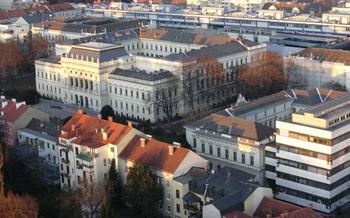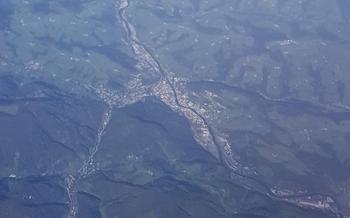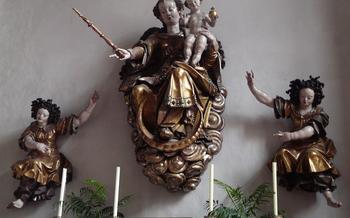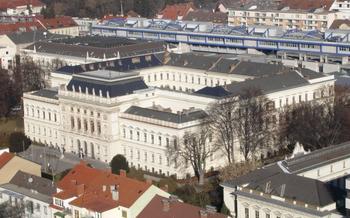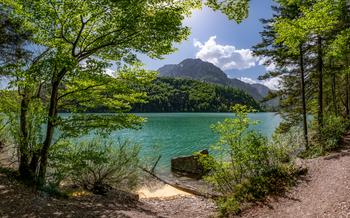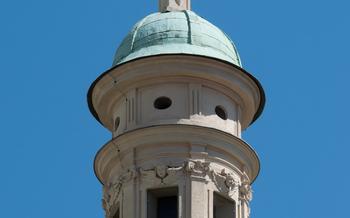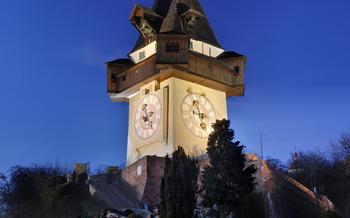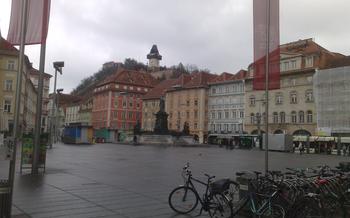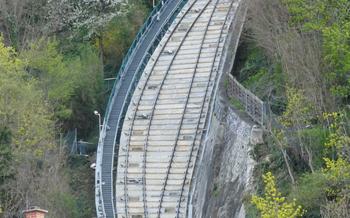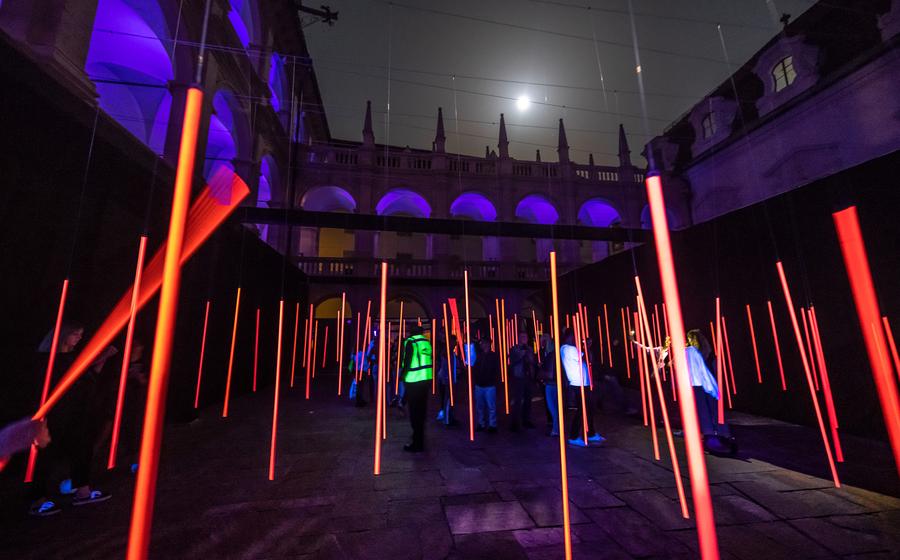
Landhaushof
- Graz's Historical Gem: Landhaushof
- A Journey Through Time: History of the Landhaushof
- Unveiling the Architectural Masterpiece
- Exploring the Inner Chambers
- The Heart of Styrian Parliament
- Landhaushof's Cultural Significance
- A Walk Through the Courtyard
- Marveling at the Double Spiral Staircase
- The Styrian Armoury: A Glimpse into the Past
- The Landhaus Chapel: A Sacred Space
- Witnessing the Changing of the Guard Ceremony
- Landhaushof Café: A Culinary Delight
- Taking a Guided Tour: Unveiling Hidden Secrets
- Insider Tip: Exploring Graz's Murinsel
Graz's Historical Gem: Landhaushof
In the heart of Graz, nestled amidst charming cobblestone streets and vibrant piazzas, stands a historical gem that embodies the city's rich cultural heritage - the Landhaushof. This magnificent Renaissance masterpiece, dating back to the 16th century, has witnessed the passage of time, serving as a testament to Graz's architectural beauty, cultural significance, and enduring legacy. With its intricate detailing, opulent halls, and captivating history, the Landhaushof invites visitors on a journey through time, unveiling the essence of Styrian autonomy and the vibrant tapestry of Graz's storied past.
A Journey Through Time: History of the Landhaushof
The history of the Landhaushof is a captivating narrative that spans centuries and intertwines with the evolution of Graz and Styria. Its origins date back to the 16th century when the Styrian Estates, seeking to assert their autonomy and independence, commissioned the construction of a magnificent building that would serve as their seat of power. This grand undertaking was entrusted to the renowned Italian architect Domenico dell'Allio, who masterfully crafted a masterpiece that would not only endure the test of time but also become a symbol of Styrian identity.
Over the centuries, the Landhaushof has undergone various transformations, reflecting the changing needs and circumstances of the Styrian Estates. It initially served as a venue for meetings and assemblies, where representatives from different parts of Styria gathered to discuss matters of governance and justice. As the region's political landscape evolved, the building also accommodated the offices of the Styrian government, solidifying its role as the center of Styrian political power.
Remarkably, the Landhaushof has managed to survive numerous wars, fires, and renovations, each leaving its own mark on the building's fabric. It has witnessed Graz's rise and fall, the Habsburg monarchy's reign, and the tumultuous events of the 20th century. Through it all, the Landhaushof has remained an enduring symbol of Styrian autonomy, a testament to the resilience of the Styrian people and their unwavering commitment to self-governance.
Unveiling the Architectural Masterpiece
The Landhaushof stands as a testament to the architectural prowess of the Renaissance era. Its facade, a symphony of intricate details and ornaments, captivates the eye with its harmonious blend of Gothic and Renaissance elements. The central courtyard, enclosed by graceful arcaded galleries, exudes a sense of grandeur and serenity. The interplay of light and shadow cast by the arches creates a mesmerizing effect, transforming the courtyard into a magical space. Each corner of the Landhaushof reveals a new architectural treasure, inviting visitors to embark on a journey through time and marvel at the artistry of its design.
Exploring the Inner Chambers
The Landhaushof's interior is as captivating as its exterior. A grand staircase, adorned with intricate carvings and polished banisters, leads visitors to the upper floors. These floors house impressive halls, each serving a specific purpose. The most prominent among them is the Landtagssaal, or Parliament Hall, where the Styrian Parliament convenes. This majestic hall features a vaulted ceiling, ornate chandeliers, and rows of wooden benches for the members of parliament.
In addition to the Landtagssaal, the Landhaushof is home to several other notable chambers. The Rittersaal, or Knights' Hall, is known for its impressive collection of medieval armor and weaponry. The Festsaal, or Festival Hall, is used for official receptions, banquets, and other special events. The Bibliothekssaal, or Library Hall, houses a valuable collection of books and manuscripts related to Styrian history and culture.
Interspersed throughout these grand halls are numerous historical artifacts and paintings, each telling a story about the Landhaushof's rich past. Portraits of former rulers, tapestries depicting historical events, and allegorical sculptures add to the building's cultural significance.
Among the most sacred spaces within the Landhaushof is the Chapel of Saint George, located on the ground floor. Dedicated to the patron saint of Styria, this chapel features beautiful stained-glass windows, intricate frescoes, and a serene atmosphere that invites contemplation and reflection.
The Heart of Styrian Parliament
Nestled within the majestic walls of the Landhaushof, the heart of Styrian democracy beats. The building serves as the seat of the Styrian Parliament, where representatives from across the region gather to debate, deliberate, and make decisions that shape the future of Styria. Visitors can witness the dynamic interplay of politics and governance firsthand as they observe the lively debates and discussions that take place within these historic halls. The Landhaushof stands as a testament to the vibrant political culture of Styria, where the voices of the people are heard and where the course of the region is charted.
A visit to the Styrian Parliament offers a unique opportunity to gain insights into the workings of democracy and to witness the intricate processes of decision-making. Guided tours provide visitors with a comprehensive overview of the parliamentary system, explaining the roles of the various bodies and the procedures followed during sessions. Whether you are a local resident or a curious traveler, exploring the Styrian Parliament is an enriching experience that sheds light on the political landscape of this vibrant region.
Landhaushof's Cultural Significance
The Landhaushof is not merely a historical and architectural marvel; it is also a vibrant cultural hub. Its grand halls and elegant courtyards serve as venues for a variety of exhibitions, concerts, and events throughout the year. These events showcase the rich cultural heritage of Styria, from traditional folk music performances to contemporary art exhibitions.
The Landhaushof's cultural significance extends beyond its role as a venue for events. It is also home to a collection of valuable paintings, sculptures, and historical artifacts that reflect the artistic and cultural heritage of the region. These treasures adorn the walls and halls of the building, adding to its allure and making it a must-visit destination for art enthusiasts and history buffs alike.
In recognition of its outstanding cultural value, the Landhaushof was designated a UNESCO World Heritage Site in 199This prestigious designation highlights the building's importance as a symbol of Graz's rich history and its contribution to the cultural landscape of Austria and Europe.
A Walk Through the Courtyard
In the heart of the Landhaushof lies a tranquil oasis, a central courtyard enveloped by graceful Renaissance arcades. Step into this serene sanctuary and let the echoes of history transport you to another era. The courtyard exudes an aura of tranquility, a refuge from the bustling city streets that surround it.
As you stroll through the courtyard, gaze upon the intricate carvings and frescoes that adorn the walls, each one a testament to the artistry and craftsmanship of bygone eras. The courtyard's harmonious blend of architectural elements creates a captivating visual symphony, where Gothic and Renaissance influences intertwine seamlessly.
Find a secluded bench beneath the shade of the arcades and take a moment to savor the peaceful ambiance. Let the gentle breeze carry the melodies of birdsong as you soak in the beauty of your surroundings. The courtyard invites you to linger, to lose yourself in contemplation, and to appreciate the simple pleasures of life.
Marveling at the Double Spiral Staircase
Amidst the architectural wonders of the Landhaushof, the double spiral staircase stands as a unique and captivating feature. Its intertwined spirals, ascending gracefully towards the upper floors, create an image of elegance and symmetry. The staircases are not merely functional but also symbolic, representing the harmonious blending of different perspectives and the unity of the Styrian people.
Carved from fine stone, the staircase boasts intricate detailing and delicate ornamentation. The banisters are adorned with intricate scrollwork, while the steps feature elaborate carvings depicting scenes from Styrian history and mythology. The interplay of light and shadow upon the staircase's surfaces creates a dynamic effect, enhancing its visual appeal.
The double spiral staircase serves as a reminder of the Landhaushof's rich history. It has witnessed countless footsteps, from noblemen and dignitaries to ordinary citizens, all contributing to the story of Styria. Ascending the staircase, visitors can imagine themselves transported back in time, experiencing the grandeur and significance of this historic building.
Whether admired from afar or experienced firsthand, the double spiral staircase of the Landhaushof is a testament to the artistry and craftsmanship that went into the creation of this architectural masterpiece. It is a symbol of Styrian pride and a must-see attraction for anyone visiting Graz.
The Styrian Armoury: A Glimpse into the Past
Housed within the majestic walls of the Landhaushof, the Styrian Armoury invites visitors on a journey through Styria's rich military history. This captivating collection showcases an array of historical weapons and armor, providing a glimpse into the region's past battles and conflicts. From gleaming swords and intricate suits of armor to formidable cannons and muskets, the exhibits offer a tangible connection to the bravery and resilience of the Styrian people.
Each piece in the armory tells a unique story, reflecting the technological advancements and cultural influences that shaped Styrian warfare. Visitors can marvel at the intricate craftsmanship of medieval armor, adorned with elaborate engravings and symbols of power. The collection also features weaponry from later periods, including muskets and pistols used in more recent conflicts.
The Styrian Armoury is not merely a display of military might; it is a testament to the region's resilience and its unwavering spirit in the face of adversity. Whether you're a history buff, a weapons enthusiast, or simply curious about Styria's past, the Styrian Armoury promises an immersive and educational experience.
The Landhaus Chapel: A Sacred Space
In the heart of the Landhaushof, a sacred sanctuary awaits visitors, dedicated to the patron saint of Styria - Saint George. The Landhaus Chapel, situated on the ground floor, exudes an aura of tranquility and spirituality. Its exquisite stained-glass windows, depicting scenes from the life of Saint George and other biblical figures, cast a warm, ethereal glow upon the interior. The walls are adorned with intricate frescoes, narrating stories of faith, hope, and divine intervention. The chapel's serene atmosphere invites visitors to pause, reflect, and connect with their spiritual side. It serves as a reminder of the deep-rooted religious traditions and cultural heritage of Styria, where faith and history intertwine to create a tapestry of spiritual devotion.
Witnessing the Changing of the Guard Ceremony
In the heart of Graz, a spectacle unfolds that transports visitors back in time. The Landhaushof, a symbol of Styrian autonomy, becomes the stage for a traditional ceremony that has been passed down through generations. The Changing of the Guard, performed by the Styrian Guard in their resplendent historical uniforms, is a captivating display of precision and discipline.
As the clock strikes the hour, the guards, impeccably dressed in 16th-century attire, emerge from the Landhaushof's grand entrance. Their footsteps echo through the courtyard as they march in perfect unison, their polished helmets and gleaming armor reflecting the sun's rays. With each step, they evoke the spirit of a bygone era, reminding visitors of the rich history embedded within these walls.
The ceremony, steeped in symbolism, represents the transfer of power and authority. The changing of the guard symbolizes the continuity of Styrian traditions and the enduring legacy of its proud heritage. Visitors from around the world gather to witness this spectacle, captivated by the guards' unwavering dedication and the vibrant display of Styrian culture.
Whether you're a history buff, a lover of tradition, or simply someone who appreciates a touch of grandeur, the Changing of the Guard Ceremony at the Landhaushof is an unforgettable experience that should not be missed. Immerse yourself in the captivating atmosphere, let the rhythm of the march transport you to another time, and witness the living legacy of Styria unfold before your eyes.
Landhaushof Café: A Culinary Delight
Nestled within the historic walls of the Landhaushof, the Landhaushof Café beckons visitors with its inviting ambiance and culinary delights. Step into this charming café and immerse yourself in the elegant atmosphere, where the past and present harmoniously blend. Savor the aroma of freshly brewed coffee as you peruse the menu, featuring a tempting array of refreshments and local delicacies.
Indulge in a slice of traditional Austrian cake, renowned for its rich flavors and exquisite presentation. Pair your sweet treat with a steaming cup of tea, relishing the moment as you soak in the beauty of your surroundings. The café's tasteful décor and soft lighting create an inviting space for relaxation, allowing you to unwind and savor the moment.
Take a break from your exploration of the Landhaushof and retreat to this culinary haven. Enjoy the tranquility of the café, nestled amidst the bustling city center. As you sip your coffee or tea, let the grandeur of the Landhaushof wash over you, immersing yourself in the rich history and cultural significance of this remarkable building.
Taking a Guided Tour: Unveiling Hidden Secrets
To delve deeper into the rich history and cultural significance of the Landhaushof, guided tours are highly recommended. Led by knowledgeable and passionate guides, these tours provide visitors with an immersive experience. As they walk through the grand halls and chambers, visitors will learn about the building's evolution, its role in Styrian politics, and the fascinating stories that have unfolded within its walls.
Guides will point out intricate details, hidden symbols, and historical artifacts that might otherwise go unnoticed. They will explain the significance of the artwork, the symbolism of the double spiral staircase, and the stories behind the various rooms and chambers. With their expertise, visitors will gain a deeper understanding of the Landhaushof's importance, both as a historical landmark and a symbol of Styrian identity.
It is advisable to book a guided tour in advance, especially during peak tourist season, to secure a spot and avoid disappointment. Whether you are a history buff, an architecture enthusiast, or simply curious about Graz's rich heritage, a guided tour of the Landhaushof is an unforgettable experience that will leave you with a lasting appreciation for this architectural masterpiece.
Insider Tip: Exploring Graz's Murinsel
Graz's Murinsel (Island in the Mur) is a must-see attraction located just a short walk from the Landhaushof. This artificial island, situated on the picturesque Mur River, showcases a striking blend of modern design and architecture. Its unique shape and structure make it a captivating landmark that complements the historic charm of the Landhaushof.
As you approach the Murinsel, you'll be greeted by its gleaming metallic exterior, which reflects the sunlight and creates a mesmerizing spectacle. The island is accessible via a pedestrian bridge, allowing you to immerse yourself in its contemporary ambiance. Once on the island, you'll discover a variety of attractions that cater to different interests.
For art enthusiasts, the Murinsel houses a contemporary art museum that showcases a diverse collection of modern and contemporary artworks. The museum's exhibitions feature both local and international artists, providing a platform for innovative and thought-provoking artistic expressions.
The Murinsel also boasts a spacious viewing platform that offers panoramic vistas of Graz's cityscape, including the iconic Landhaushof. From this vantage point, you can admire the city's architectural treasures, the meandering Mur River, and the surrounding green hills.
If you're seeking a culinary experience, the Murinsel is home to a charming restaurant that serves a delectable menu of regional and international cuisine. Indulge in a delicious meal while savoring the stunning views of the city and the Landhaushof.
The Murinsel is a vibrant hub of activity, hosting various events, concerts, and festivals throughout the year. Check the event calendar to see if anything of interest coincides with your visit.
Whether you're an art aficionado, a nature lover, or simply seeking a unique experience, the Murinsel is a must-visit destination that offers a refreshing contrast to the historical charm of the Landhaushof.
